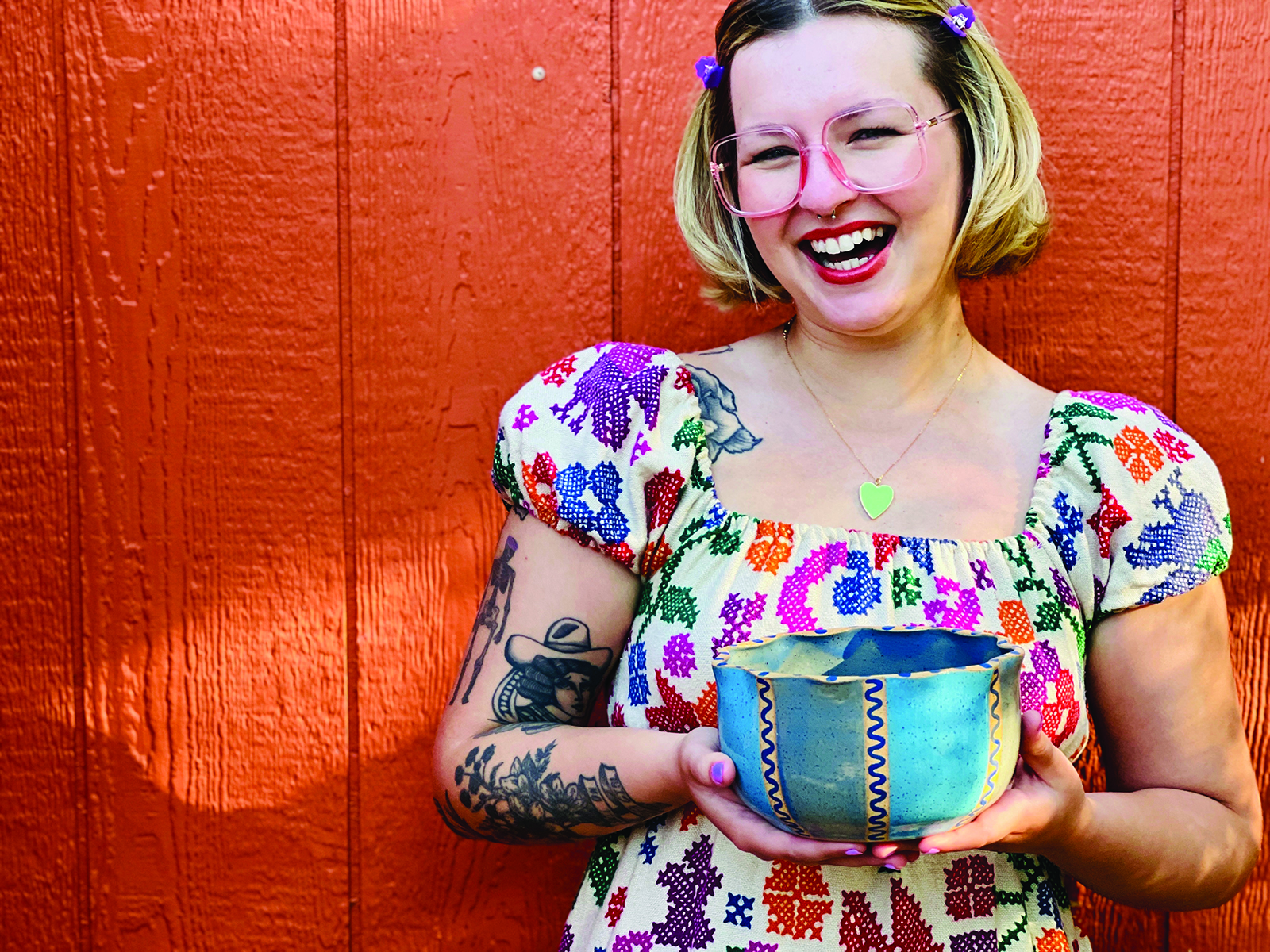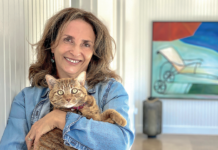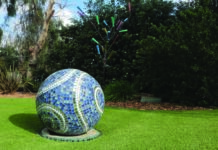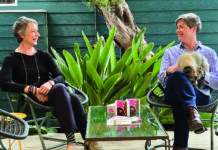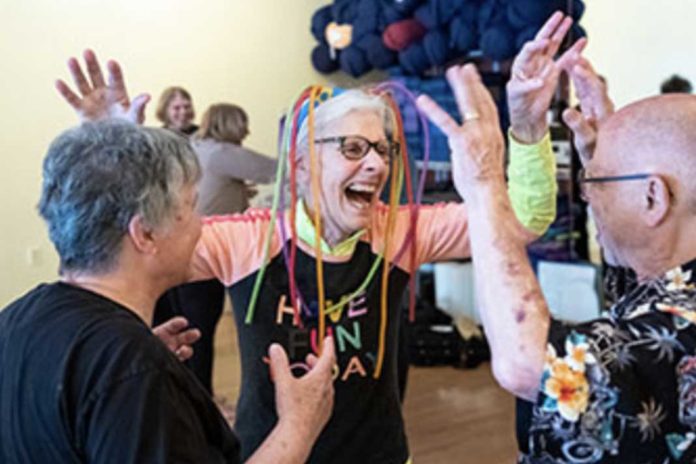
Photo by Mike Baker
LET IT GO: There’s no room for embarrassment during a laughter yoga session, where getting silly is the point – and the prescription for less stress, more endorphins and overall well-being.
all this yoga, do you? With no mats, poses or a single down dog?
Instead, grown men and women are strutting about the Camarillo Yoga Center, clapping their hands, flapping their arms, crowing like roosters, beep-beeping like roadrunners, jabbering in gibberish (French gibberish, yet), and all the while laughing and behaving as if they were, well, far less grown up than it says on their driver’s licenses. And often, at the end of class, far more ready, willing and able to enjoy life, and one another, than they were when they entered the CYC 45 minutes earlier.
These are the devotees of laughter yoga, a form of exercise which seeks relaxation and rejuvenation of the mind, body and spirit through the simple (if unconventional) use of intentional laughter techniques which bring about deep breathing that, in turn, boosts the intake of oxygen into the body, decreases cortisol (the stress hormone) and releases endorphins, all helpful in improving energy levels and overall well-being.
Or, as laughter yoga co-leader Joan Woodward says, “Laughter yoga is all BS — breath and smile.”
“We’re here to support one another”
A typical session at CYC starts with simple, rhythmic clapping to laughter syllables: ho, ho, ha-ha-ha, ho-ho, ha-ha-ha, with participants high- and low-fiving each other, and — above all — making eye contact.
“That’s essential,” explains Jim Riley, another LY co-leader, whose regular job as a Caltrans engineer rarely produces the frivolity about to ensue. “We’re here to support one another as much as we are to be silly.”
Soon, Riley is running his group through a series of exercises — a cowboy chortle (slap your knees and guffaw), a milkshake giggle (mix it up and pour it on yourself and each other), a penguin walk, an ants-in-your-pants shimmy — with periodic rests.
Don’t worry, says Riley, if your laughter isn’t always as genuine as you think it should be.
“The laughter muscle doesn’t know real from forced,” he grins. “The benefits are the same. So fake it ’til you make it.”
“Exercises” don’t last more than 15 or 20 seconds. But if it induces laughter and participants open their minds, hearts and internal giggle-boxes, the benefits add up.
“It has a subtle effect,” smiles Paul, a technical writer who’s attended LY sessions “off and on” for over 10 years. “My work can be rather serious, and I find I’m much more attuned to subtle puns or humor in life, and maybe have more verbal agility, after doing these strange exercises. And the play aspect is just wonderful.”
Priscilla, a service veteran, says LY has helped her deal with PTSD and depression. “When you laugh,” she says, “the endorphins kick in, your brain chemistry changes and you walk away feeling more positive about yourself. I can come in here, enjoy being silly with everyone and feel better for two weeks, just in time for the next class.”
“It’s great to be accepted and to accept others,” says Thelma, a retired teacher who began coming a few years ago. “I guess I was too serious for a while. The world moves so fast, we’re always stressing about something, and by coming to this group, having fun, making eye contact, we can deal much better with all that stuff in life that drags us down.”
Debbie, another longtime attendee who works during the week with crime victims, delights in the diversity of the group.
“We’ve had folks in their 80s and 90s who are so cherished by the group, even if they aren’t as agile or mobile,” she smiles. “You’re accepted wherever you are at, and that alone helps lighten your load, to be surrounded by these amazing people.”
“Genuine belly laughter”
The health benefits of laughter were noted in Norman Cousins’ book, Anatomy of an Illness, in which the author, diagnosed with a terminal illness, watched old Candid Camera TV shows and film comedies as part of his self-prescribed therapy.
“I made the joyous discovery,” Cousins wrote, “that ten minutes of genuine belly laughter had an anesthetic effect and would give me at least two hours of pain-free sleep.”
In the mid-1990s, Dr. Madan Kataria of India experimented by having test groups share jokes and funny stories. After realizing that the jokes became less funny over time (or perhaps weren’t that funny to start with), Kataria and his wife, Madhuri, a yoga instructor, developed a series of exercises that substituted laughter for deep breathing.
So was born laughter yoga, which Kataria believed for fullest effectiveness required a group setting in which the focus was on healing, not necessarily on comedy.
“All the group members,” Kataria says in a Youtube video, “must understand that what we are doing in a laughter yoga session is not an entertainment or amusement. . . . We are doing exercises, cardiovascular exercises.”
“Set aside your serious side”
Laughter yoga’s therapeutic effects have impacted many, including Roni Tagliaferri, a Camarillo cancer survivor and yoga practitioner who in the early 2000s was so inspired by Kataria’s work that she trained to become a laughter yoga leader, leading sessions at Camarillo Yoga Center with the blessing of CYC founder-owner Audrey Walzer.
“It’s lots of deep breathing that’s also fun and light-hearted,” says Tagliaferri, who led LY sessions almost every Saturday for nine years at CYC before retiring and training the current leaders. “I tell people, ‘Set aside your serious side.’ Because you’re engaging with people who are active, full of life and excitement. And it’s not gonna hurt you; if anything, it relaxes you.”
Both the physical and psychological health benefits, she says, “are amazing,” whether people participate because of physical, emotional or spiritual health concerns. “It’s hope and it’s health-giving, good for everyone. And there is this amazing energy, love and care in the group that gives you such a re-charge when you come. When you dump happiness on someone else, you dump it on yourself.”
Walzer, a yoga teacher for 48 years, is an occasional class participant and fully supports laughter yoga, offering her studio at no charge for the Saturday sessions.
“It is different than traditional yoga because it takes you to places that, as adults, can make us uncomfortable,” she notes. “So often, adults have this image of themselves that gets in the way of being able to have fun. But in laughter yoga, all you’re doing is playing, which is what you’d be doing if you had a 3-year-old with you. And that’s a valuable part of living.”
Physiologically, Walzer explains, when you laugh, you breathe, “and good laughing means you breathe in more oxygen. And psychologically, your mental attitude affects how your body responds to illness or even just the stresses of daily life. And the more positive your attitude, the better your body can respond. Laughter helps you get to a positive place.”
A universal language
Few are more positive than co-leader Woodward, an energetic, outgoing former marine biologist who looks and acts nothing like a 76-year-old grandmother.
“Laughter yoga is about playfulness,” she says. “Find your inner child, allow that child to play — laugh, breathe and release. You won’t experience it the same way each time, or the same as anyone else. It’s about connecting with others through the vibrations of laughter.”
As a hospice volunteer, Woodward has used laughter yoga to connect with patients. Anyone can do it, regardless of age, size, station in life or even language.
“All you need to bring,” says Walzer, “is comfortable clothing, an open mind and your curiosity.”
Woodward’s husband, Lee, who teaches conversational English in Camarillo, brought his class with people from Ecuador, Mexico, the Ivory Coast and Iran to experience laughter yoga. All were embraced by the group, and communicated just fine.
“Laughter,” smiles Woodward, “is an international language.”
At the end of each session, LY participants gather for a “laughter meditation,” a bit of “free-form” laughter and quiet time, before “sending out” joy and happiness to anyone and everyone in the world they feel could benefit — which, Woodward notes, “is a lot of everyones.”
The class closes with a simple mantra: “We are the happiest people in the world. We are the healthiest people in the world. We are the luckiest people in the world.”
And given the smiles on their faces, who’s going to argue?
Laughter Yoga classes are free and take place on alternate Saturdays, 12:30-1:15 p.m
No pre-registration is required.
CAMARILLO YOGA CENTER
5800 Santa Rosa Road
805.484.8810
www.camarilloyoga.com

GOOD VIBES: Class ends on a sweetly serene note (above), with participants engaging in a bit of “laughter meditation,” a quieter but equally joyous time of sending happiness out into the universe.

“Laughter yoga is all BS — breath and smile,” says laughter yoga leader Joan Woodward.







